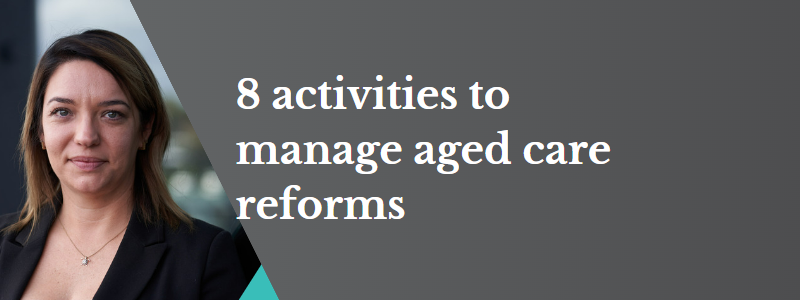How to ensure quality care while maintaining financial viability
June 2, 2023 | Aged Care Management

By Katie Airey, Quality, Risk and Compliance Lead
The aged care reforms have brought a lot of changes to the sector to improve care outcomes for older people. These changes have also aimed to support providers’ financial viability. However, Stewart Brown’s latest sector report shows that 63% of homes were operating at a loss in December 2022 – compared to 60% at December 2021.
It is important that we recognise that without financial stability, the goal of achieving high quality care is unattainable. We also know from the history of the last several changes of funding model that the industry has been slow to adopt the new rules which directly impacts financial viability. To achieve high quality care that enables older people to obtain the support and services they need, providers will need to come up the learning curve more quickly so that they truly understand the aged care reforms and the impact these changes will have on their organisation.
What does this mean for providers?
To support improvements in risk monitoring the Australian National Aged Care Classification (AN-ACC) claim data will be made available to the Aged Care Quality and Safety Commission. This data, along with other regulatory intelligence, will be used to assess providers response to minimum care minute target requirements and suitability of their skills mix within their services. This is in addition to the responsibility of approved providers under the Aged Care Act to maintain an adequate number of appropriately skilled staff to ensure the care needs of care recipients are met. Residential aged care providers that do not have an appropriately skilled workforce are at risk of not meeting the Aged Care Quality Standards.
Providers will align their workforces’ skills mix to the resident case mix within their homes to remain compliant, but this can take on many forms. Models of care across the industry vary widely and can be adapted to meet availability constraints region by region and the varying complexity of care required service by service. The legislation requires that consumers receive high quality care based on their needs, goals and preferences. Strategies should deliver that but should also seek to boost trust and confidence in the performance of the aged care sector.
There is more funding than ever to contribute to improving care outcomes and business viability. The introduction of AN-ACC in October 2022 slingshot subsidy growth well past the comparative measures of the consumer price index (CPI) and awards. In July 2023, the Aged Care Award and subsidy will both realise the largest jumps in the history of Australian aged care. Over the past 8 years, wages and subsidy have grown by 36%, with subsidy playing significant catchup in the last year. This further affirms the direct takeaway from the Royal Commission that providers must spend more on clinical and direct care.
How each provider disperses this funding through their model of care and roster demand templates has massive implications for compliance and sustainability of their organisation. Providers have visibility of the mandated care minutes and can see what subsidy revenue they will be entitled to. This allows each facility to determine the budget for the appropriate skill mix based on their defined model of care, which in turn provides a target for subsidy management and a known position in relation compliance.
Given the above, providers should also consider the cost of poor care delivery. The sector is working towards achieving high quality care, through improved transparency and data-informed risk identification. Providers will need to strive towards higher expectations. The key is understanding the components of the reform and using your organisations data to make informed decisions.
How are providers balancing all these requirements?
More than ever before, it is the balance that is critical. AN-ACC and Star Ratings have joined together funding, care minutes (rosters) and quality more than ever before. Increasing Quality and Safety Commission activity also has providers on notice that time is running out to get their house in order.
Here is a list of several activities you should have underway in your business:
- Improved reporting at a management level to provide oversight on daily funding and care minutes, including forecasting your July 1(new price) and October 1 (new care minute levels) changes.
- Improved systems and data capability at a resident level to support decision making for your funding team on reclassification potential.
- Embedding a new process for reviewing all residents for potential changes in AN-ACC on a minimum 2-3 monthly basis.
- Efficient care minute reporting for quarterly financial reporting (QFR) process and working on the ability to forecast your position within the quarter.
- A review of the efficiency of your rosters and what is the optimal (normal) operating balance between funding and care minutes for each facility.
- An efficient rostering process (system) with costed rosters and shift offers to allow you to make real time decisions on cost and availability of staff to avoid agency as much as possible.
- A review process on the new quality indicators (currently in first quarter of data collection) and planning beginning on the new standards and impact on your operations
- An understanding of your Star Ratings and how each element is affected by the above initiatives, what your overall strategy is and how you can make short term improvements to your ratings.
We are helping more than a hundred providers every month to address the initiatives above.
Want to learn more? Reach out to our team.


